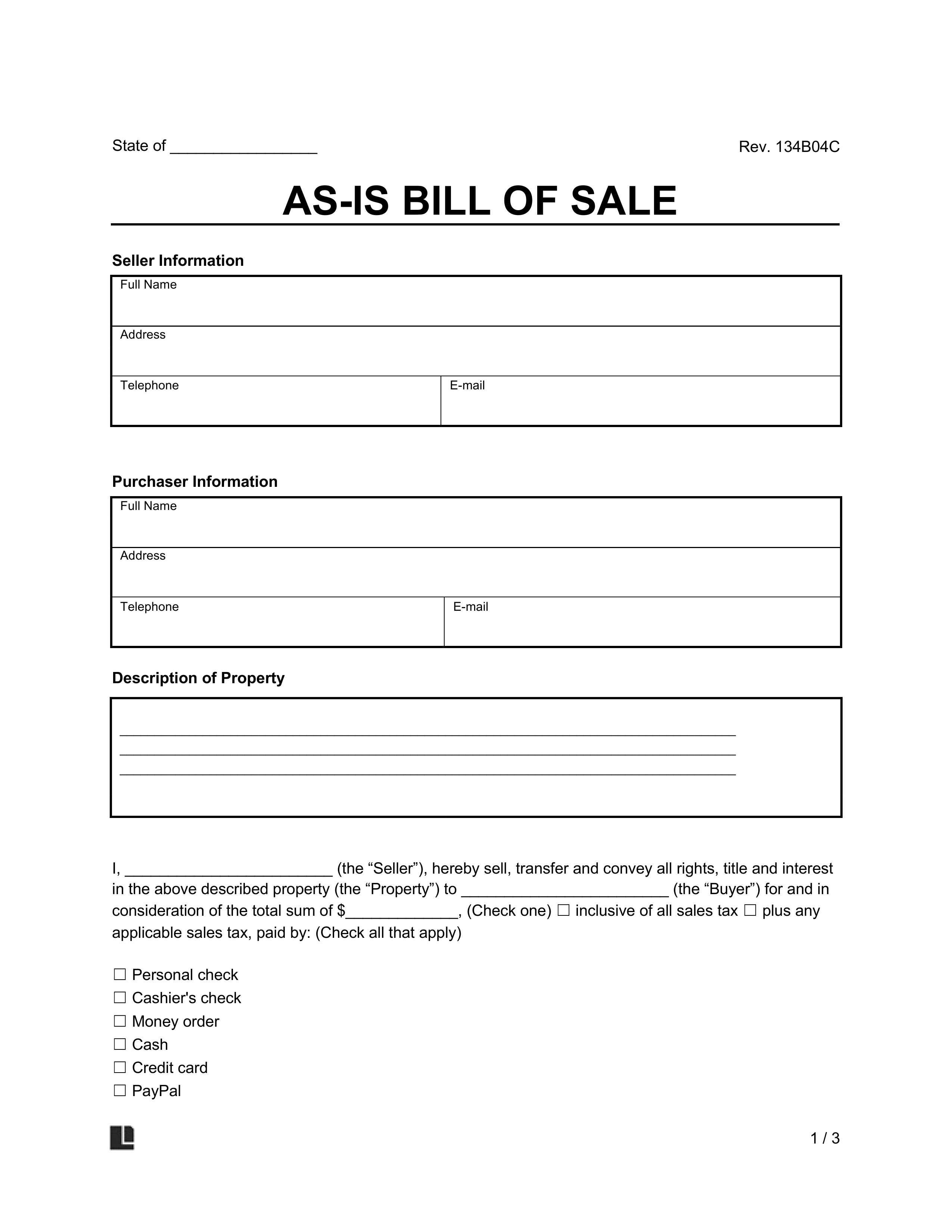An as-is bill of sale means the buyer agrees to purchase the item in its current condition, regardless of what that condition is. The buyer agrees to accept the item with any known or potentially unknown defects in the property. The seller does not warranty or guarantee anything about the item when selling it.
An as-is bill of sale helps document that you are selling the item in as-is condition.
What Is an As-Is Bill of Sale?
An as-is bill of sale is a legal document that proves a buyer is purchasing a thing in its current and present condition without any warranties from the seller. Once the transaction or sale is complete, ownership and title to the property will transfer to the buyer.
A bill of sale document is evidence of the sale and the critical details of that sale. It helps to prove the transfer of an item and may be required by state law for certain types of transfers. For example, several states require a bill of sale for motor vehicle transactions. An as-is bill of sale documents many of the same details but clarifies that the seller gives no warranties regarding the item’s condition.
What Does No Warranties Mean?
No warranties means that the bill of sale does not make any promises about the condition of the property or the seller’s rights in that property. It grants all of the seller’s rights to the buyer as they currently exist.
It also sells the property as it is in its current condition, with no promises about the quality of that item.
Typical Uses For an As-Is Bill of Sale
An as-is bill of sale is commonly used for transactions such as:
- Motor vehicles
- Trailers
- Bicycles
- Boats
- Motorcycles
- Personal property
- Campers
What Should an As-Is Bill of Sale Include?
An as-is bill of sale should include the pertinent details of the transaction and the other critical elements of the legal document. These include:
- Seller and buyer information
- Description of the property
- The legal language that transfers ownership from the seller to the buyer
- A section to include that the property’s condition is “as-is.”
- Signature and date lines for both parties
- Notary acknowledgment section
How To Write an As-Is Bill of Sale
You should complete the following steps to write your as-is bill of sale.
Step 1: Download Your As-Is Bill of Sale
You can download an as-is bill of sale template to sell your vehicle or another item. You can download the form in both Microsoft Word or PDF formats.
You can fill out the as-is sale bill of sale template on your computer or print it and complete it by hand.
Step 2: Add the State of the Sale
At the top of your as-is bill of sale form is a line for the state where the transaction occurs. This can be vital information so that you meet the legal requirements of that particular state to transfer your property.
Step 3: Add Seller and Purchaser Contact Information
Your as-is bill of sale should list important contact information for the seller and the purchaser of the as-is property. This information should include all of the following:
- Each party’s full name
- Each party’s address (house number, city, state, and zip code)
- Each party’s telephone number
- Each party’s email address
Contact information identifies the parties and provides critical information if a dispute or issue arises with the transaction later.
Step 4: Provide a Description of the Property
The as-is bill of sale form is designed to transfer many different property types. You should use this section to describe clearly:
- The nature of the item that is being transferred (what is it?)
- The current condition of the property
- Details about the item, such as color, size, and other descriptive elements
- If selling a vehicle, the make, model, and vehicle identification number
- Any known issues with the item (this is helpful even though you are selling the item as-is)
Be descriptive about your item. The document should be clear about what item you are transferring so there is no dispute about what you purchased or sold.
Step 5: Use Legal Language To Transfer the Property
Your as-is bill of sale template should have the appropriate language to transfer the item from the seller to the buyer. It should convey all rights, titles, and interests in the property to the buyer for consideration of a specific amount. This legal language clarifies that the document is a bill of sale and legally effectuated the property transfer.
Step 6: Include Price Details
Your as-is bill of sale document should list the price the property is sold for. It should also state how the property is paid for (for example, personal check, cashier’s check, cash, credit card, etc.)
The price information is often critical to getting title and registration to properties like motor vehicles.
Step 7: Include “As-Is” Language
Your bill of sale form should include the “as-is” language and that the buyer accepts the item in its current condition. The as-is section should also state that the seller transfers the property “without any guarantees or warranties of any kind, express or implied.”
This legal language clarifies that the transaction is as-is and does not grant any warranty or guarantee on the property’s condition.
Step 8: Both Parties Sign the As-Is Bill of Sale Form
Both parties must sign and date the as-is bill of sale form. Your template should include a separate line for each of the following:
- Each party’s full printed name
- Each party’s signature
- A date next to each signature
As-Is Bill of Sale Sample
Below, you can download a sample as-is bill of sale in PDF or Word format.

